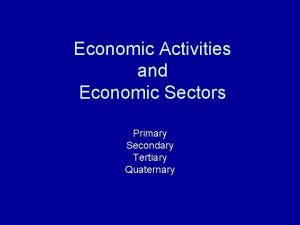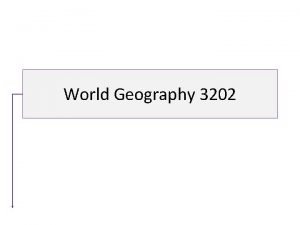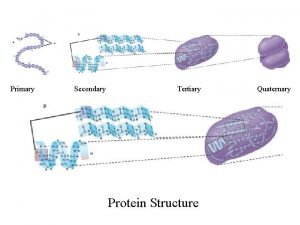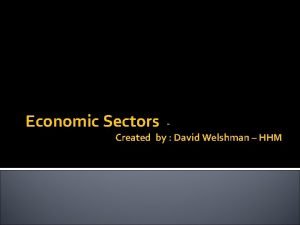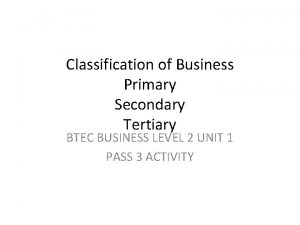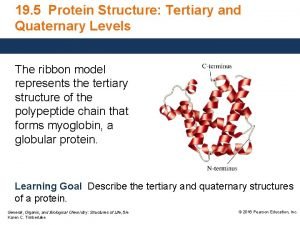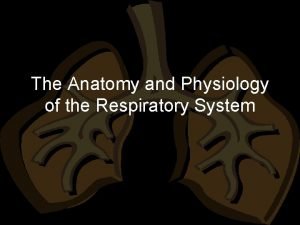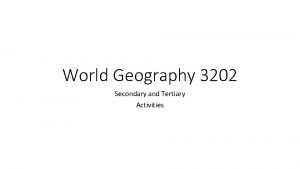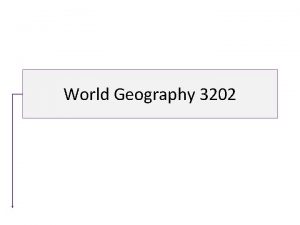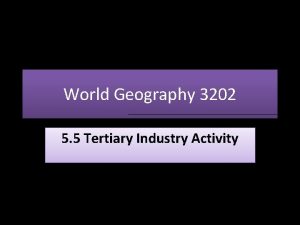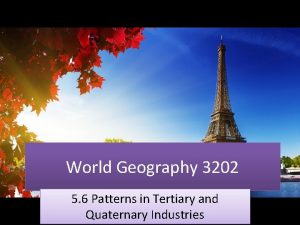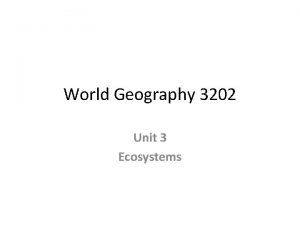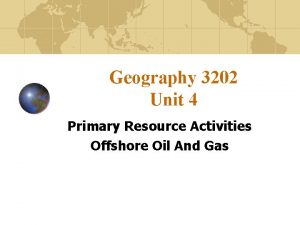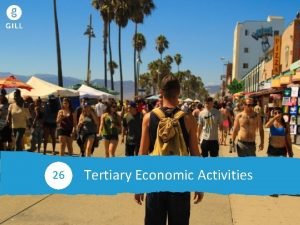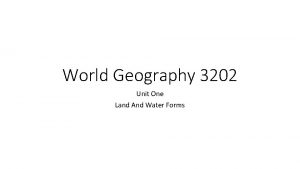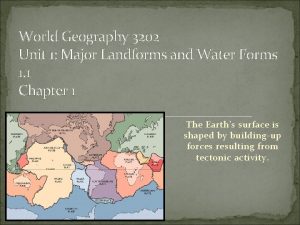World Geography 3202 Secondary and Tertiary Activities Unit

















- Slides: 17

World Geography 3202 Secondary and Tertiary Activities

Unit 5 • Gives us insight into selected secondary activities in which humans engage as they transform raw materials, provided by primary activities, to more finished forms. • Manufacturing utilizes capital and labour inputs to move materials through a series of processes until a higher-value added product is obtained. • Services involve the “manufacturing” of intangible goods or services for human use. • You will examine the importance of the secondary and tertiary sectors and factors that help to account for their location

Three Sectors of the Economy • Primary economic activity involves the collection of raw materials from the earth. Farming, fishing, mining, forestry are the classic parts of the primary economy. • The farmer takes plants from the land, the forester takes trees from the forest, the fisher takes fish from the ocean and the miner takes ore from the ground. • All involve collecting natural resources.

Three Sectors of the Economy • Secondary economic activity involves processing or manufacturing raw materials into products for people to buy. • It is often referred to as the manufacturing or processing sector. The cows are butchered in to roasts, T-bone steaks and ground beef and packaged for sale at the grocery store; the trees are milled into lumber or pulped into paper; the fish are gutted, filleted, and frozen for market; while the ore is refined into steel ribbons or copper wire or gold ingots. • You can see that there would be a multitude of examples for secondary processing but all the activities start with a raw material and convert it to a product for sale. • This is sometimes referred to as Value adding. • The tree would be much less expensive to buy than the lumber. The lumber has value added. Ship building, as depicted above, is an example of the manufacturing sector.

Three Sectors of the Economy • Tertiary economic activity does not involve raw materials rather it involves providing service to people. • Hence it is often referred to as the service industry. • Nurses, doctors, lawyers, teachers, waitresses, hairdressers, sales people all provide services for other people. • Tourism is an important part of the tertiary sector and golf has become a thrust for investment in Newfoundland & Labrador.

The Language of Manufacturing • Inputs: materials & factors that go into making a product. Example; raw material, power, buildings, land, labor, decisions, capital, machinery • Manufacturing processes: those processes that change a raw material to a usable form. Three types: • Conditioning: minimal change to a resource. Example; logs into lumber; fish into fillets • Analytical: resource converted to a number of different products. Example; cow into leather, milk & cheese • Synthetic: several resources are combined to make one resource. Example; light bulb has glass, tungsten, Nitrogen & aluminum. • Outputs: finished product from a manufacturing process. For example the output from the fish plant is fish sticks or frozen fish fillets.

Labour Intensive vs. Capital Intensive • Industry can be classified in many different ways: • We shall look at two ways of classifying industry. • Manufacturing businesses can be classified based on the process. • All manufacturing businesses can be classified as either requiring large quantities of labour or of machinery to do the processing.

Labour Intensive vs. Capital Intensive • Machinery now does much of the work formerly done by humans. • Some manufacturing businesses might be more difficult to classify because they require large quantities of both capital labour. • Labor intensive: requires a lot of person hours to produce the product. Ex. Jewelry making • Capital intensive: requires a lot of expensive equipment to make the product. Ex. Automotive industry

Heavy vs. Light Industry • Manufacturing businesses can be classified based on the output. • All manufacturing businesses can be classified as either producing large, expensive items for other business to use in manufacturing or transportation or as producing small items for consumers to purchase directly.

Heavy vs. Light Industry • Some manufacturing businesses might be more difficult to classify because they produce items that might be used by business or by private people. • Heavy industry: produces big expensive products for other industry. Ex. Ship yard, tractor production • Light Industry: produces products for consumers. Ex. Pop industry.

Factors that influence the location of an industry • Site/Physical Cost Factors • Three major factors of site (physical location) • Proximity to raw material. Heavier & bulkier the raw material the closer the industry will be located to reduce transportation costs. • resource oriented industry • industries that are located close to the resource because it is to heavy/bulky to transport; • communities frequently spring up around resource industries. Labrador City, Churchill Falls, Grand Falls-Windsor and Bonavista are good examples. Can you think of other examples? • Land: price, level, good drainages, dense well-settled soil • Energy: not as important a factor today due to our ability to transport power long distances.

Human-based Cost Factors • Market Oriented Industry • Industries that are located close to the market because the product is expensive to transport. The resources are not bulky or expensive to transport. The Soft drink industry is a good example. • Market vs. Resource Oriented Industries: • As we examine the influence of “weight gain” & “weight loss” on the location of industry we see that if the product weight is greater (weight gain) than the input resources it is located near market. Conversely if product weight is less (weight loss) than the input resources it is located near resource.

Human-based Cost Factors • Agglomerating Tendency • Agglomerating tendency refers to the tendency for factories producing related products to locate close to each other for mutual benefit. Ex. Car factory & tire factory. How does each benefit by being located close to each other? • Industrial Parks • Industrial parks provide many advantages for a business. Existing infrastructure of roads, on ramps and off ramps to highways, large lots, sewer, ample electricity, and close location to related industries make industrial parks attractive for manufacturing businesses.

Human-based Cost Factors • Labor force characteristics that attract business • Wages expected: lower wages in some developing countries like Mexico, and the Philippines attract manufacturers • Training: highly skilled labourers can attract businesses that require welders, mechanics, carpenters etc. • Benefits (EI, Pensions etc); lower costs of employment insurance, pensions , etc. can attract business just as easily as low wages. • Availability; a high unemployment rate might attract business, especially if large numbers of workers are required

Government Influence • Transportation subsidies affect the location of industry. • Subsidies allow businesses to locate farther from the resourse. • Subsidies allow governments to encourage industry in rural areas. Examples: • • ice breakers in Botwood; roads in Labrador; cost of coastal transportation in Labrador; cost of crossing the Gulf.

Government Influence • Tax breaks affect the location of Industry. • Provinces like Newfoundland have attempted to attract business by offering tax breaks. The company obtains a financial break while the province gets the advantage of putting people to work.

Industry Location; The Global Picture • The highly industrialized areas on the earth's surface are concentrated in 4 definite regions: • North America • Western Europe • Japan • Australia
 Primary activities and tertiary activities
Primary activities and tertiary activities Quaternary economic activities are those that
Quaternary economic activities are those that Types of tertiary activities
Types of tertiary activities Quaternary sector
Quaternary sector Oxidation primary alcohol
Oxidation primary alcohol Primary secondary tertiary
Primary secondary tertiary Primary secondary tertiary
Primary secondary tertiary Levels of care primary secondary tertiary
Levels of care primary secondary tertiary Tertiary consumer in a food web
Tertiary consumer in a food web What is primary processing of food
What is primary processing of food Primary secondary and tertiary sector
Primary secondary and tertiary sector Primary sector business
Primary sector business Sewage treatment primary secondary and tertiary
Sewage treatment primary secondary and tertiary Primary secondary and tertiary protein structure
Primary secondary and tertiary protein structure Primary bronchi
Primary bronchi Primary secondary and tertiary bronchi
Primary secondary and tertiary bronchi Pleura
Pleura Tertiary production examples
Tertiary production examples

